Abnormal Strong Upwelling off the Coast of Southeast Vietnam in the Late Summer of 2016: A Comparison with the Case in 1998
Abstract
:1. Introduction
2. Data and Methods
2.1. Data
2.2. Methods
3. Results
3.1. Breaking Down the El Niño-Weak Upwelling Connection off the Coast of Southeast Vietnam in August 2016
3.2. Contrasting Upwelling Structures
3.3. Linkage with Large-Scale Circulations
4. Discussion
5. Conclusions
Author Contributions
Funding
Acknowledgments
Conflicts of Interest
References
- Bakun, A.; Agostini, V.N. Seasonal patterns of wind-induced upwelling/downwelling in the Mediterranean sea. Sci. Mar. 2001, 65, 243–257. [Google Scholar] [CrossRef]
- Hu, J.; Wang, X. Progress on upwelling studies in the China seas. Rev. Geophys. 2016, 54, 653–673. [Google Scholar] [CrossRef]
- Wyrtki, K. Physical Oceanography of the Southeast Asian Waters; University of California, Scripps Institution of Oceanography: La Jolla, CA, USA, 1961; p. 155. [Google Scholar]
- Zhang, Y.; Sperber, K.R.; Boyle, J.S. Climatology and interannual variation of the East Asian winter monsoon: Results from the 1979–95 NCEP/NCAR reanalysis. Mon. Wea. Rev. 1997, 125, 2605–2619. [Google Scholar] [CrossRef]
- Gan, J.; Li, H.; Curchitser, E.N.; Haidvogel, D.B. Modeling South China Sea circulation: Response to seasonal forcing regimes. J. Geophys. Res. 2006, 111, C06034. [Google Scholar] [CrossRef]
- Wu, R.S.; Li, L. Summarization of study on upwelling system in the South China Sea. J. Oceanogr. Taiwan Strait. 2003, 22, 269–276. (In Chinese) [Google Scholar]
- Qu, T. Upper-layer circulation in the South China Sea. J. Phys. Oceanogr. 2000, 30, 1450–1460. [Google Scholar] [CrossRef]
- Udarbe-Walker, M.J.B.; Villanoy, C.L. Structure of potential upwelling areas in the Philippines. Deep Sea Res. Part I 2001, 48, 1499–1518. [Google Scholar] [CrossRef]
- Chang, Y.L.; Oey, L.Y.; Wu, C.R.; Lu, H.F. Why are there upwellings on the northern shelf of Taiwan under northeasterly winds? J. Phys. Oceanogr. 2010, 40, 1405–1417. [Google Scholar] [CrossRef] [Green Version]
- Hong, H.; Chen, C.T.A.; Jiang, Y.; Lou, J.; Chen, Z.; Zhu, J. Source water of two-pronged northward flow in the southern Taiwan Strait in summer. J. Oceanogr. 2001, 67, 385–393. [Google Scholar] [CrossRef]
- Wang, D.; Shu, Y.; Xue, H.; Hu, J.; Chen, J.; Zhuang, W.; Zu, T.; Xu, J. Relative contributions of local wind and topography to the coastal upwelling intensity in the northern South China Sea. J. Geophys. Res. Oceans. 2014, 119, 2550–2567. [Google Scholar] [CrossRef]
- Roxy, M.K.; Modi, A.; Murtugudde, R.; Valsala, V.; Panickal, S.; Prasanna Kumar, S.; Ravichandran, M.; Vichi, M.; Lévy, M. A reduction in marine primary productivity driven by rapid warming over the tropical Indian Ocean. Geophy. Res. Lett. 2016, 43, 826–833. [Google Scholar] [CrossRef] [Green Version]
- Kuo, N.J.; Zheng, Q.; Ho, C.R. Satellite observation of upwelling along the western coast of the South China Sea. Remote Sens. Environ. 2000, 74, 463–470. [Google Scholar] [CrossRef]
- Ho, C.R.; Kuo, N.J.; Zheng, Q.; Soong, Y.S. Dynamically active areas in the South China Sea detected from TOPEX/POSEIDON satellite altimeter data. Remote Sens. Environ. 2000, 71, 320–328. [Google Scholar] [CrossRef]
- Xie, S.P.; Xie, Q.; Wang, D.; Liu, W.T. Summer upwelling in the South China Sea and its role in regional climate variations. J. Geophys. Res. Ocean. 2003, 108. [Google Scholar] [CrossRef] [Green Version]
- Gan, J.; Qu, T. Coastal jet separation and associated flow variability in the southwest South China Sea. Deep Sea Res. Part I 2008, 55, 1–19. [Google Scholar] [CrossRef]
- Zu, T.; Wang, D.; Wang, Q.; Li, M.; Wei, J.; Geng, B.; He, Y.; Chen, J. A revisit of the interannual variation of the South China Sea upper layer circulation in summer: Correlation between the eastward jet and northward branch. Clim. Dynam. 2020, 54, 457–471. [Google Scholar] [CrossRef]
- Dippner, J.J.W.; Nguyen, K.K.V.; Hein, H.; Ohde, T.; Loick, N. Monsoon-induced upwelling off the Vietnamese coast. Ocean. Dynam. 2007, 57, 46–62. [Google Scholar] [CrossRef]
- Wang, D.; Wang, H.; Li, M.; Liu, G.; Wu, X. Role of Ekman transport versus Ekman pumping in driving summer upwelling in the South China Sea. J. Ocean. Univ. China 2013, 12, 355–365. [Google Scholar] [CrossRef]
- Hein, H.; Hein, B.; Pohlmann, T.; Long, B.H. Inter-annual variability of upwelling off the South-Vietnamese coast and its relation to nutrient dynamics. Global Planet. Change 2013, 110, 170–182. [Google Scholar] [CrossRef]
- Liu, X.; Wang, J.; Cheng, X.; Du, Y. Abnormal upwelling and chlorophyll-a concentration off South Vietnam in summer 2007. J. Geophys. Res. Ocean. 2012, 117. [Google Scholar] [CrossRef] [Green Version]
- Xie, S.P.; Hu, K.; Hafner, J.; Tokinaga, H.; Du, Y.; Huang, G.; Sampe, T. Indian Ocean capacitor effect on Indo–western Pacific climate during the summer following El Niño. J. Clim. 2009, 22, 730–747. [Google Scholar] [CrossRef]
- Isoguchi, O.; Kawamura, H. MJO-related summer cooling and phytoplankton blooms in the South China Sea in recent years. Geophy. Res. Lett. 2006, 33. [Google Scholar] [CrossRef]
- Xie, S.P.; Chang, C.H.; Xie, Q.; Wang, D. Intraseasonal variability in the summer South China Sea: Wind jet, cold filament, and recirculations. J. Geophys. Res. Ocean. 2007, 112. [Google Scholar] [CrossRef]
- Xiao, F.; Zeng, L.; Liu, Q.Y.; Zhou, W.; Wang, D. Extreme subsurface warm events in the South China Sea during 1998/99 and 2006/07: Observations and mechanisms. Clim. Dynam. 2018, 50, 115–128. [Google Scholar] [CrossRef]
- Wang, D.; Xie, Q.; Du, Y.; Wang, W.; Chen, J. The 1997–1998 warm event in the South China Sea. Chin. Sci. Bull. 2002, 47, 1221–1227. [Google Scholar]
- Xiao, F.; Wang, D.; Zeng, L.; Liu, Q.Y.; Zhou, W. Contrasting changes in the sea surface temperature and upper ocean heat content in the South China Sea during recent decades. Clim. Dynam. 2019, 53, 1597–1612. [Google Scholar] [CrossRef]
- Xiao, F.; Wang, D.; Yang, L. Can tropical Pacific winds enhance the footprint of the Interdecadal Pacific Oscillation on the upper-ocean heat content in the South China Sea? J. Clim. 2020, 33, 4419–4437. [Google Scholar] [CrossRef] [Green Version]
- Paek, H.; Yu, J.Y.; Qian, C. Why were the 2015/2016 and 1997/1998 extreme El Niños different? Geophy. Res. Lett. 2017, 44, 1848–1856. [Google Scholar] [CrossRef]
- Xiao, F.; Wang, D.; Leung, Y.T. Early and extreme warming in the South China Sea during 2015/16: Role of an unusual Indian Ocean dipole event. Geophy. Res. Lett. 2020. [Google Scholar] [CrossRef]
- Tang, D.; Kawamura, H.; Shi, P.; Takahashi, W.; Guan, L.; Shimada, T.; Sakaida, F.; Isoguchi, O. Seasonal phytoplankton blooms associated with monsoonal influences and coastal environments in the sea areas either side of the Indochina Peninsula. J. Geophys. Res. Biogeosci. 2006, 111. [Google Scholar] [CrossRef]
- Lu, W.; Oey, L.Y.; Liao, E.; Zhuang, W.; Yan, X.; Jiang, Y. Physical modulation to the biological productivity in the summer Vietnam upwelling system. Ocean. Sci. 2018, 14, 1303–1320. [Google Scholar] [CrossRef] [Green Version]
- Reynolds, R.W.; Smith, T.M.; Liu, C.; Chelton, D.B.; Casey, K.S.; Schlax, M.G. Daily high-resolution-blended analyses for sea surface temperature. J. Clim. 2007, 20, 5473–5496. [Google Scholar] [CrossRef]
- Sathyendranath, S.; Grant, M.; Brewin, R.J.W.; Brockmann, C.; Brotas, V.; Chuprin, A.; Doerffer, R.; Dowell, M.; Farman, A.; Groom, S.; et al. ESA Ocean Colour Climate Change Initiative (Ocean_Colour_cci): Version 3.1 Data; Technical Report; Centre for Environmental Data Analysis: Harwell, UK, 2018. [Google Scholar]
- Carton, J.A.; Chepurin, G.A.; Chen, L. SODA3: A new ocean climate reanalysis. J. Clim. 2018, 31, 6967–6983. [Google Scholar] [CrossRef]
- Kalnay, E.; Kanamitsu, M.; Kistler, R.; Collins, W.; Deaven, D.; Gandin, L.; Iredell, M.; Saha, S.; White, G.; Woollen, J.; et al. The NCEP/NCAR 40-Year Reanalysis Project. Bull. Am. Meteorol. Soc. 1996, 77, 437–472. [Google Scholar] [CrossRef] [Green Version]
- Xie, P.; Arkin, P.A. Global precipitation: A 17-year monthly analysis based on gauge observations, satellite estimates, and numerical model outputs. Bull. Am. Meteorol. Soc. 1997, 78, 2539–2558. [Google Scholar] [CrossRef]
- Liebmann, B.; Smith, C.A. Description of a complete (interpolated) outgoing longwave radiation dataset. Bull. Am. Meteorol. Soc. 1996, 77, 1275–1277. [Google Scholar]
- Chu, J.H.; Sampson, C.R.; Levine, A.S.; Fukada, E. The Joint Typhoon Warning Center tropical cyclone best tracks 1945–2000. In Joint Typhoon Warning Center Rep., Ref. NRL/MR/7540-02-16; Naval Research Laboratory: Washington, DC, USA, 2002. [Google Scholar]
- Pickett, M.H.; Paduan, J.D. Ekman transport and pumping in the California Current based on the US Navy’s high—Resolution atmospheric model (COAMPS). J. Geophys. Res. Ocean. 2003, 108, 3327. [Google Scholar] [CrossRef]
- Smith, R.L. Upwelling. Oceanogr. Mar. Biol. An. Annu. Rev. 1968, 6, 11–46. [Google Scholar]
- Larkin, N.K.; Harrison, D.E. On the definition of El Niño and associated seasonal average US weather anomalies. Geophy. Res. Lett. 2005, 32. [Google Scholar] [CrossRef]
- Saji, N.H.; Goswami, B.N.; Vinayachandran, P.N.; Yamagata, T. A dipole mode in the tropical Indian Ocean. Nature 1999, 401, 360–363. [Google Scholar] [CrossRef]
- Bakun, A. Coastal Upwelling Indices, West Coast of North America, 1946–1971. In US Dept. Commerce NOAA Tech. Rep. National Marine Fishery Service (NMFS)–Special Scientific Report; Fisheries (SSRF): Seattle, WA, USA, 1973; pp. 1–103. [Google Scholar]
- Behrenfeld, M.J.; O’Malley, R.T.; Siegel, D.A.; McClain, C.R.; Sarmiento, J.L.; Feldman, G.C.; Milligan, A.J.; Falkowski, P.G.; Letelier, R.M.; Boss, E.S. Climate-driven trends in contemporary ocean productivity. Nature 2006, 444, 752–755. [Google Scholar] [CrossRef]
- Dave, A.C.; Lozier, M.S. Examining the global record of interannual variability in stratification and marine productivity in the low-latitude and mid-latitude ocean. J. Geophys. Res. Ocean. 2013, 118, 3114–3127. [Google Scholar] [CrossRef]
- Yoshida, K. Coastal upwelling off the California coast. Rec. Oceanogr. Work Jpn. 1955, 2, 8–20. [Google Scholar]
- Chiang, J.C.H.; Vimont, D.J. Analogous Pacific and Atlantic meridional modes of tropical atmosphere–ocean variability. J. Clim. 2004, 17, 4143–4158. [Google Scholar] [CrossRef]
- Zhan, R.; Wang, Y.; Liu, Q. Salient differences in tropical cyclone activity over the western North Pacific between 1998 and 2016. J. Clim. 2017, 30, 9979–9997. [Google Scholar] [CrossRef]
- Lindzen, R.S.; Nigam, S. On the role of sea surface temperature gradients in forcing low-level winds and convergence in the tropics. J. Atmos. Sci. 1987, 44, 2418–2436. [Google Scholar] [CrossRef] [Green Version]
- Matsuno, T. Quasi-geostrophic motions in the equatorial area. J. Meteorol. Soc. Jpn. Ser. II 1966, 44, 25–43. [Google Scholar] [CrossRef] [Green Version]
- Gill, A. Some simple solutions for heat-induced tropical circulation. Q. J. Roy. Meteorol. Soc. 1980, 106, 447–462. [Google Scholar] [CrossRef]
- Xing, N.; Li, J.; Li, Y.K. A theoretical explanation of anomalous atmospheric circulation associated with ENSO Modoki during boreal winter. Atmos. Ocean. Sci. Lett. 2014, 7, 352–357. [Google Scholar]
- Zhang, Y.; Li, J.; Xue, J.; Feng, J.; Wang, Q.; Xu, Y.; Wang, Y.; Zheng, F. Impact of the South China Sea summer monsoon on the Indian Ocean dipole. J. Clim. 2018, 31, 6557–6573. [Google Scholar] [CrossRef]
- Murakami, H.; Wang, B.; Kitoh, A. Future change of western North Pacific typhoons: Projections by a 20-km-mesh global atmospheric model. J. Clim. 2011, 24, 1154–1169. [Google Scholar] [CrossRef] [Green Version]
- Emanuel, K. A statistical analysis of tropical cyclone intensity. Mon. Wea. Rev. 2000, 128, 1139–1152. [Google Scholar] [CrossRef]
- Zhang, W.; Vecchi, G.A.; Murakami, H.H.; Villarini, G.G.; Jia, L. The Pacific meridional mode and the occurrence of tropical cyclones in the western North Pacific. J. Clim. 2016, 29, 381–398. [Google Scholar] [CrossRef]
- Chen, G.; Wang, K. Why is the tropical cyclone activity over the western North Pacific so distinct in 2016 and 1998 following super El Niño events? J. Meteorol. Soc. Jpn. Ser. II 2018. [Google Scholar] [CrossRef] [Green Version]
- Yu, J.; Li, T.; Tan, Z.; Zhu, Z. Effects of tropical North Atlantic SST on tropical cyclone genesis in the western North Pacific. Clim. Dynam. 2016, 46, 865–877. [Google Scholar] [CrossRef]


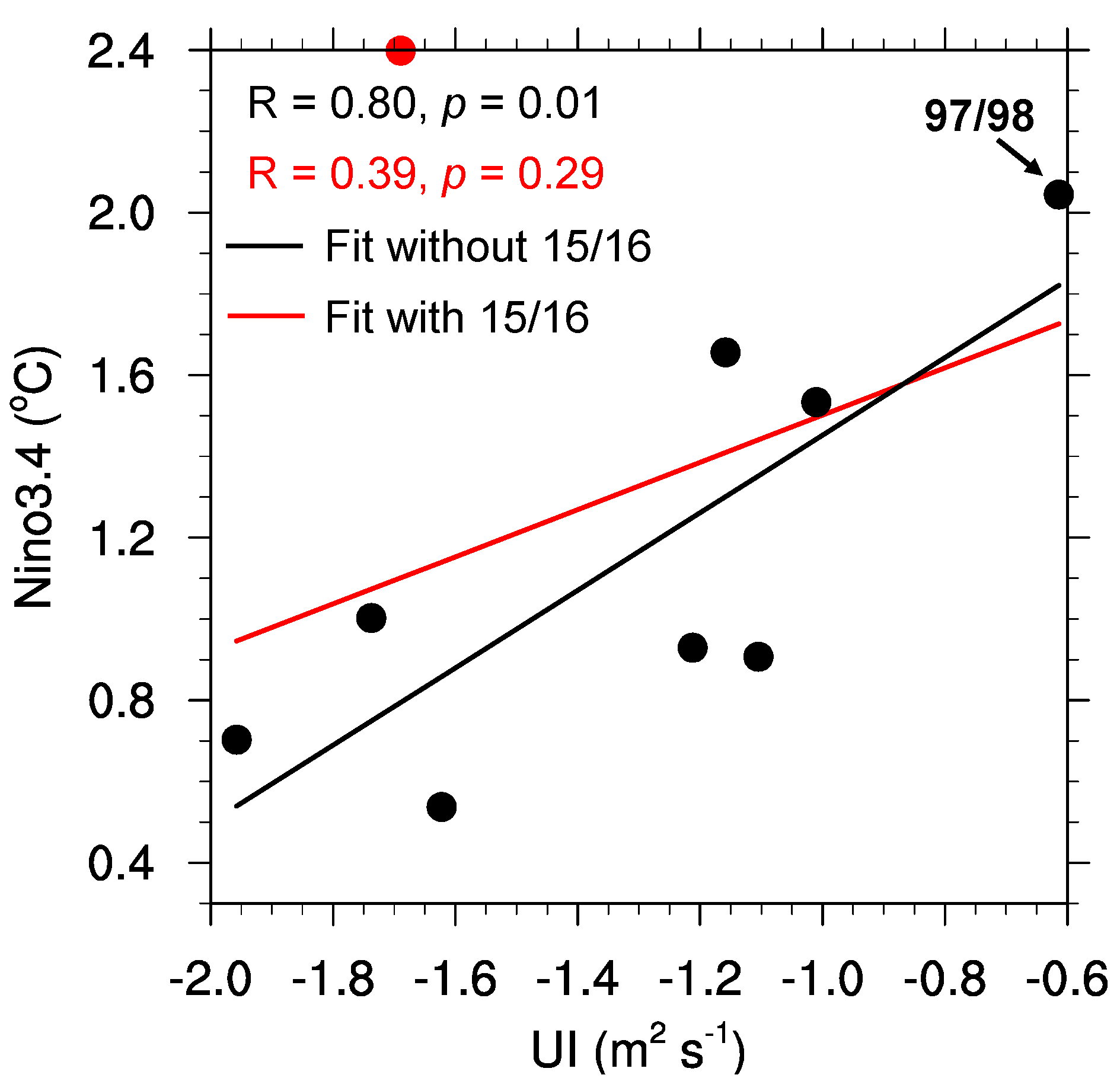
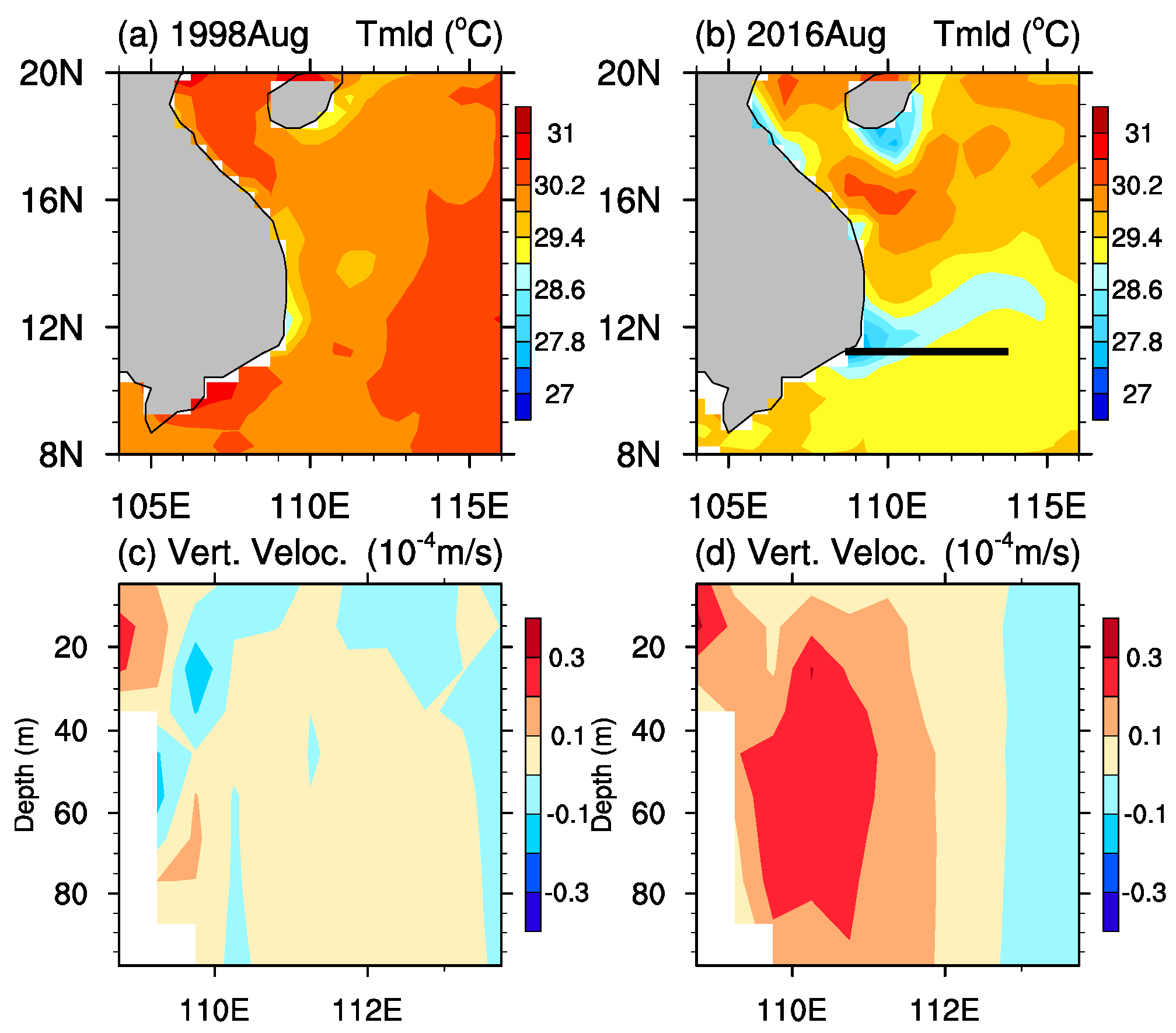
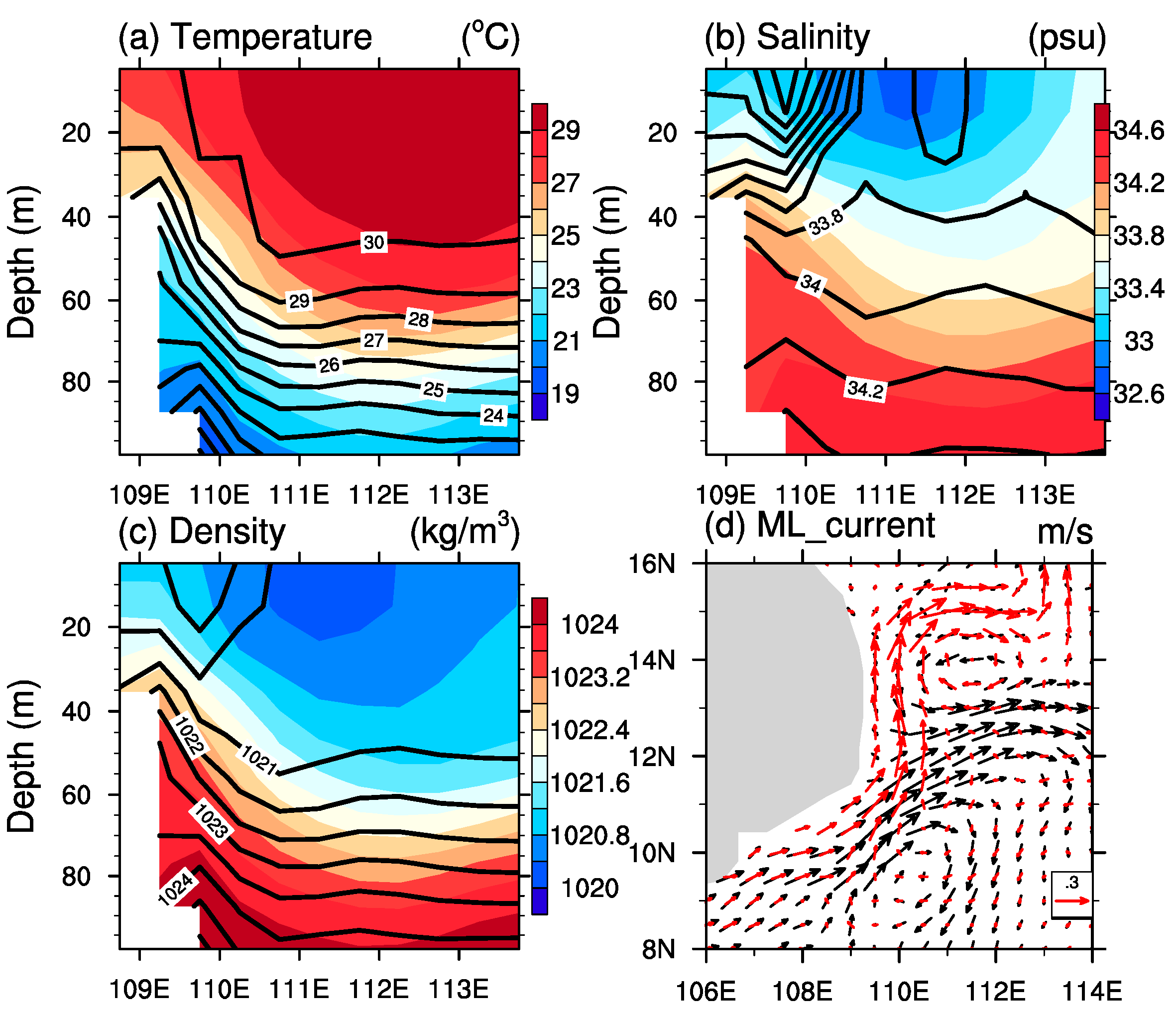
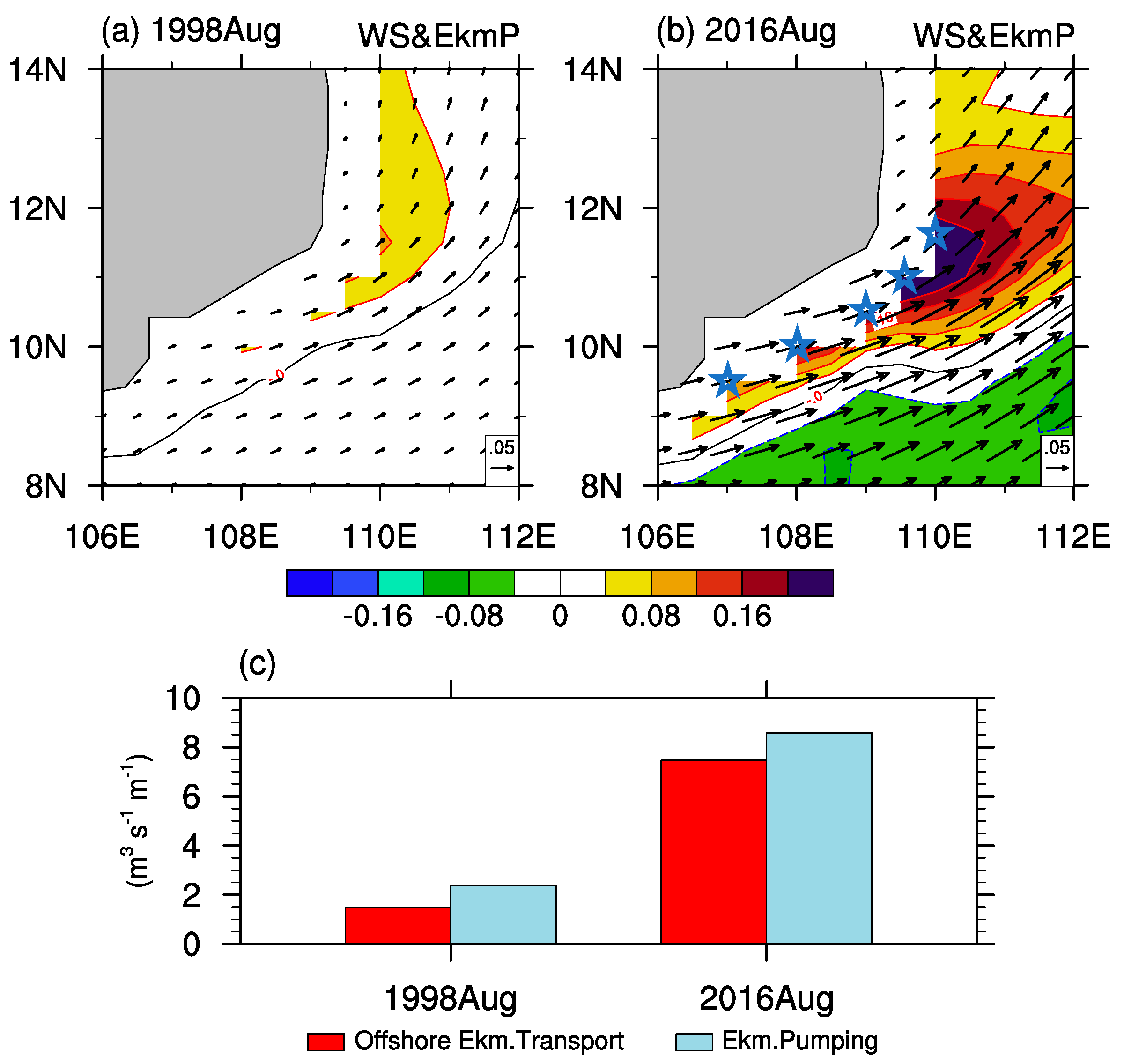


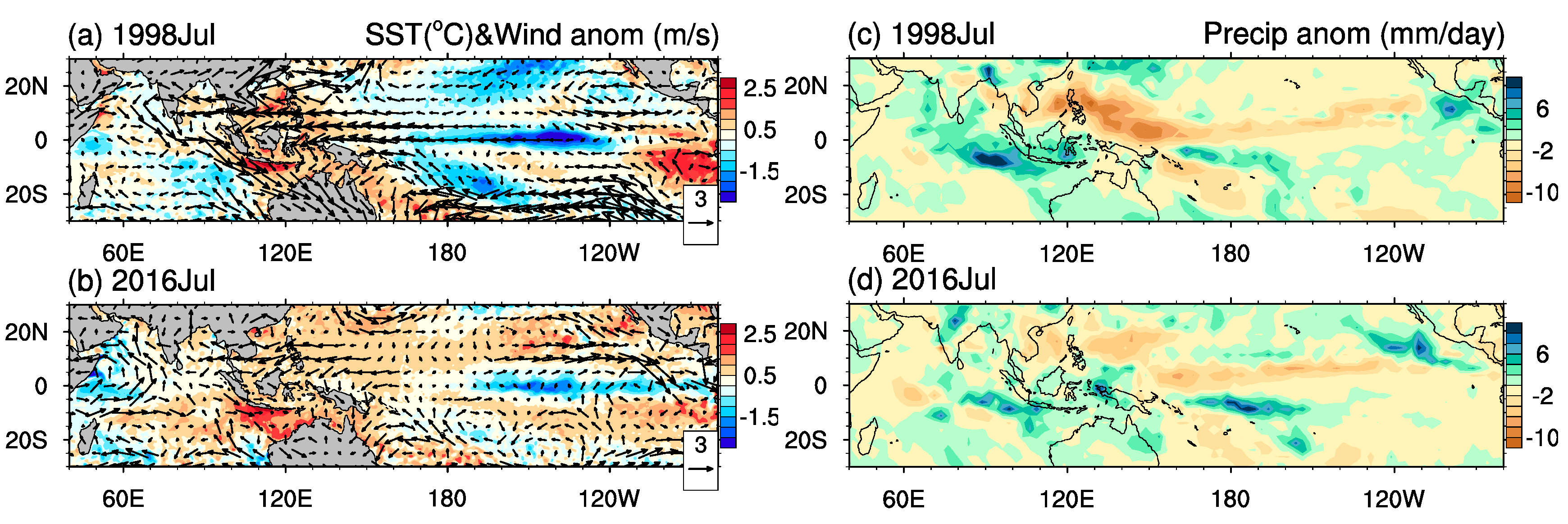
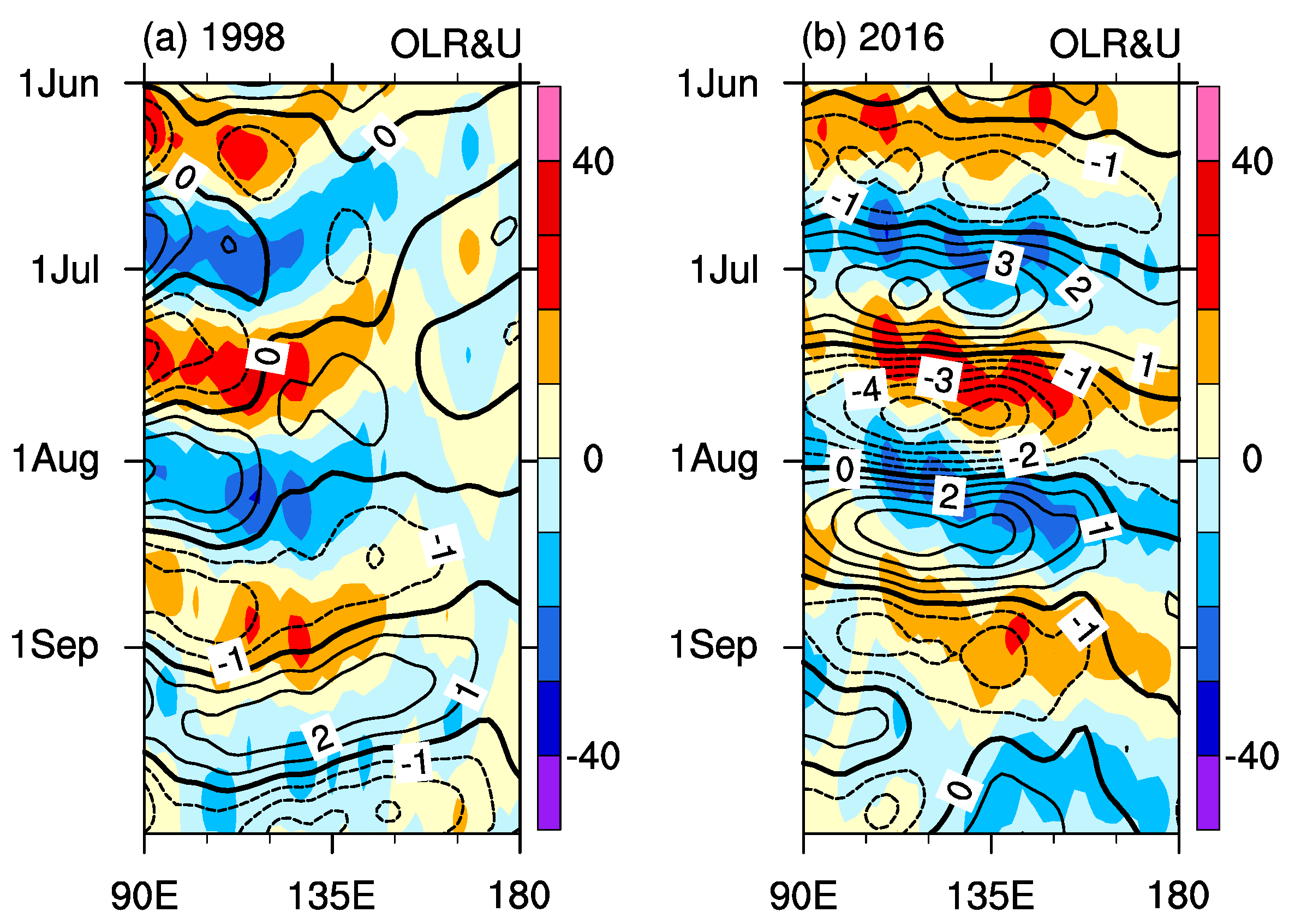


© 2020 by the authors. Licensee MDPI, Basel, Switzerland. This article is an open access article distributed under the terms and conditions of the Creative Commons Attribution (CC BY) license (http://creativecommons.org/licenses/by/4.0/).
Share and Cite
Xiao, F.; Wu, Z.; Lyu, Y.; Zhang, Y. Abnormal Strong Upwelling off the Coast of Southeast Vietnam in the Late Summer of 2016: A Comparison with the Case in 1998. Atmosphere 2020, 11, 940. https://doi.org/10.3390/atmos11090940
Xiao F, Wu Z, Lyu Y, Zhang Y. Abnormal Strong Upwelling off the Coast of Southeast Vietnam in the Late Summer of 2016: A Comparison with the Case in 1998. Atmosphere. 2020; 11(9):940. https://doi.org/10.3390/atmos11090940
Chicago/Turabian StyleXiao, Fuan, Zhifeng Wu, Yushan Lyu, and Yicen Zhang. 2020. "Abnormal Strong Upwelling off the Coast of Southeast Vietnam in the Late Summer of 2016: A Comparison with the Case in 1998" Atmosphere 11, no. 9: 940. https://doi.org/10.3390/atmos11090940
APA StyleXiao, F., Wu, Z., Lyu, Y., & Zhang, Y. (2020). Abnormal Strong Upwelling off the Coast of Southeast Vietnam in the Late Summer of 2016: A Comparison with the Case in 1998. Atmosphere, 11(9), 940. https://doi.org/10.3390/atmos11090940





